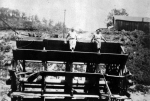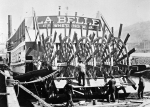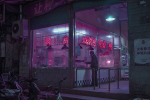K.M. Alexander's Blog, page 29
July 18, 2019
Attribution Not Required
Starting today, all of my free brush sets will migrate from Creative Commons Attribution 4.0 International License (CC BY 4.0) to a Creative Common, No Rights Reserved License (CC0). The sets themselves are using icons, signs, and symbols taken from maps that are hundreds of years old and largely in the public domain, the sets should be as well, and using my work shouldn’t require attribution.
I’m a big supporter of Creative Commons and the work they do, and as a professional designer for nearly twenty years, I’m a firm believer that artists should get credit. Licensing is an integral part of the design process but trying to credit someone can be tricky, in particular with CC BY 4.0 licenses and especially when using it on client work.
The CC BY 4.0 was a solid starting point, but I think I can do better. I want to see more writers, game masters, and game designers use my sets carte blanche—and while it’s neat to see my name in credits, I’m not making these sets for an ego boost. I should get out of the way and let the work you make shine through. It’ll be easier to use these without the attribution requirement and moving to a CC0 license will help facilitate that.
It’ll take a while for me to roll out an update to all my sets, as I need to update the README files and PNGs then reupload the new versions to my site. That’ll happen over the next few weeks. These versions won’t have any different content, they’ll just have updates to the license. So if you’re happy with the set, there will be no need to re-download the files. Going forward, don’t worry about crediting me.
So, the tl;dr version:
All my sets are now CC0. Including previously released sets.
Updates are coming soon.
Use these brushes for whatever.
You don’t have to credit me. Attribution isn’t required.
Good luck with all your projects. I look forward to seeing the amazing things you create.

July 17, 2019
The Faux-Language of Piracy
Ahoy, matey! I know we’re still a few months away from International Talk Like A Pirate Day, but I came across this great video from Cheddar examining the dialect of the foul-mouthed buccaneers from the Golden Age of Piracy.
While we have all heard of walkin’ the plank and dead men tellin’ no tales, the stereotypical language we often associate with those scurvy sea dogs is more myth than reality and heavily influenced by popular culture. You can find out more by watching the video below.
July 15, 2019
A Riverboat’s Paddlewheel
Oceangoing ships would opt for screw propulsion earlier than their riverboat counterparts. While constant contact with the water was beneficial in rough ocean conditions, it posed a detriment in early river travel. The wear and tear on screws were harsher in clogged and snag-prone conditions. Major damage could incapacitate a packet boat, and it was much easier for a riverboat’s carpenter to make repairs to a vessel’s above-water paddlewheel rather than a submerged screw prop.
A paddlewheel also allowed riverboats to ride at a shoal draft which permitted navigation among the shallow western tributaries. This helped extend the packet’s reach further inland. While future engineering would deepen and clean rivers, those early benefits allowed paddlewheels to be the dominant propulsion for almost a century.
[image error]Two Misses in Memphis, 1906—The sidewheeler Belle of the Bends taking on cargo alongside the sternwheeler Belle of Calhoun. ( See the full sized image over at Shorpy. )
Packets came in two distinct and common varieties dictated by their paddlewheel placement: the elegant sidewheeler and the labor-ready sternwheeler[1]. Early in their history, it was much easier to balance a pair of wheels at either side of the vessel — at first amid-ship but later moved just one-third forward of the stern. These boats proved superior to the cumbersome keelboats from earlier eras and quickly overtook the river trade. Their enormous paddleboxes or wheelhouses were bold, showy, and elegant. Early on, they proved to have some distinct advantages. Sidewheelers had a more stable foundation. On two-engine boats, one wheel could be reversed which allowed the packet greater maneuverability. As they became more popular, many captains grew to prefer the look, and the paddleboxes provided a foundation for wide traveler promenades.
“The sidewheel river packet is the most beautiful creation of man.”
—Captain Ellias C. Mace[2]
Unlike the sidewheeler, the sternwheeler was not as well-loved. Early sternwheelers were slow, ungainly, and unbalanced. As Hunter says in Steamboats on the Western Rivers: “Compared with the side-wheeler it was a dull, cart-horse sort of boat, useful only for the meaner kinds of work. For speed, pleasing lines, and flashing performance, the sidewheeler stood first from beginning to end; it was the western river steamboat par excellence.”[3]
[image error] Detail of the blueprints of the 1912 towboat Captain Stuart. Click here to view the full blueprints.
Par excellence or not, technology and construction methods improved, and the sternwheel’s advantages began to outshine their formerly-favored cousins. The wheel at the aft allowed the hull to serve as a bulwark from logs, ice, and other debris which could jam or damage a wheel. Because of that, those packets didn’t have to stop as readily to avoid accident. As other methods of construction were developed, the sternwheeler’s capacity for hauling cargo was significantly increased. Single aft wheels were lighter and allowed for a wider beam which enabled a more shallow draft. This helped them become masters of the smaller tributaries. By the 1880s it was said that a sternwheeler under the same load as a sidewheel vessel of similar size would draw less than half as much water—an essential aspect of river trade.
My long-standing work in progress, Coal Belly, is a sprawling weird-west fantasy adventure set on a planet which is crisscrossed by interlocking rivers. Along the rivers of Achus, both side and sternwheeled steamboats are ubiquitous. In a world where massive rivers are the dominant source of transportation, trade, and security, I felt it was important for me to understand the advantages and disadvantages of riverboat propulsion. Understanding small details can have vast implications for a story, and while second world fantasy easily allows for historical aberration, it’s always beneficial to ground aspects of worldbuilding in reality.
Below are some photos of riverboat’s wheels, both side and stern, which I’ve gathered during the years of my research for Coal Belly. You can click on any photo to view it larger. I’ve tried to group them together so you can see sidewheels, stern wheels, and some of the odder experimentations.
























As will all my riverboat research posts, all the images above were collected over the last six years, so I am unsure where they all come from (usually the Library of Congress or from research at my local libraries.) But, they’re all old enough they should all be in the public domain. If something looks or seems amiss, please let me know and I’ll correct it.
In some cases, I did some minor color correction and cropping to keep it all visually consistent. I’m happy to answer any questions folks have about any of these images or riverboats in general. (Sometimes it gives me a good excuse to research something.) You can send me an email or leave a comment below.
More Riverboats
A Riverboat’s Paddlewheel is the latest in my series of posts sharing my research for my future novel Coal Belly. You can check out the other riverboat-related posts with the links below.
A Riverboat’s Passengers
A Riverboat’s Demise
A Riverboat’s Pilothouse
Riverboats at War
A Riverboat’s Roustabouts
A Riverboat’s Menu
Riverboat Interiors
Riverboats & Levees
The Masonic Ironclad
Footnotes and Citations
1 The key word here is “common.” There were a few outliers, of course. Ferries were often centerwheelers, with the paddlewheel built along the vessels beam and the boat constructed around it. There was also the batwing steamers—small vessels with two tiny side-wheels near the stern.
2 Mace, Ellis Clarence, 1862-. River Steamboats And Steamboat Men: a History With Articles And Pictures From My Scrap Book. Cynthiana, Ky.: The Hobson book press, 1944.
3 Hunter, Louis C, and Beatrice Jones Hunter. Steamboats On the Western Rivers: an Economic And Technological History. Cambridge: Harvard University Press, 1949.
 Want to stay in touch with me? Sign up for Dead Drop, my rare and elusive newsletter. Subscribers get news, previews, and notices on my books before anyone else delivered directly to their inbox. I work hard to make sure it’s not spammy and full of interesting and relevant information. SIGN UP TODAY →
Want to stay in touch with me? Sign up for Dead Drop, my rare and elusive newsletter. Subscribers get news, previews, and notices on my books before anyone else delivered directly to their inbox. I work hard to make sure it’s not spammy and full of interesting and relevant information. SIGN UP TODAY →
July 10, 2019
Raunch Review: The Smurfs
Raunch Reviews is a series about profanity. Not real profanity, but speculative swearing. Authors often try to incorporate original, innovative forms of profanity into our own fantastical works as a way to expand the worlds we build. Sometimes we’re successful. Often we’re not. In this series, I examine the faux-profanity from various works of sci-fi and fantasy, judge their effectiveness, and rate them on an unscientific and purely subjective scale. This is Raunch Reviews, welcome.
[image error]Raunch Review: The Smurfs
The Author: Raja Gosnell & Jordan Kerner
Work in Question: The Smurfs (2011)
The Profanity: “Smurf”
I grew up watching and loving Peyo’s The Smurfs. I had Smurf bed sheets, pajamas, and more. The series holds a special place in my heart, which means it’s hard for me to tackle this one. There are moments in the original when the modified “smurf” is cute. It adds an air of whimsy which works for a species of tiny Belgian pixies. Things can be described as “smurftastic” or “just smurfy.” Or it can get more complex and verbs and nouns can be replaced; when you’re “going to the woods” you could be “smurfing to the smurf.” (All of this is detailed on the Wikipedia page.)
But, the 2011 movie The Smurfs decided to dispense with the charm. “Smurf” ceased replacing nouns and verbs and instead, the word mutated into a faux-profanity. “Smurf” as vulgarity is stupid. (“You smurfed with the wrong girl!”) As an oath, it’s even worse. (“Oh… my… smurf.”) And don’t get me started seeing its use as an intensifier. (“Up the smurfin’ creek without a paddle…”) Yet, that didn’t stop the movie from using “smurf” over and over and over in these contexts. Why remains a mystery. It tears away the whimsical and innocent goofiness from the original use and replaces it with a puerile gag that doesn’t make a whole lot of sense. It’s not even offensive in its crudeness—it’s just lazy writing.
This adds nothing to the world, and you could even go as far as saying it takes something away. Detraction is distraction, and that is always bad news on Raunch Reviews. “Smurf” in this instances does nothing to build the lore. There is no connection to the worldbuilding outside a shoddy mimicry of times past. It’s a clumsy intensifier at best, and one of the worst faux-profanities I’ve reviewed. Shame, boo, and… I mean, what did you expect?
Score: [image error][image error][image error][image error][image error] (0.0)
Previous Raunch Reviews
“Dren” from Rockne S. O’Bannon’s Farscape
“Quiznak” from J. Dos Santos & L. Montgomery’s Voltron: Legendary Defender
“Smeg” from Rob Grant and Doug Naylor’s Red Dwarf
“Burn Me” from Robert Jordan’s The Wheel of Time
“Slitch” from Robert A. Heinlein’s Friday
“Yarbles” from Anthony Burgess’ A Clockwork Orange
“Cuss” from Wes Anderson’s Fantastic Mr. Fox
“Feth” from Dan Abnett’s Gaunt’s Ghosts from Warhammer 40k
“Shazbot” from Garry Marshall’s Mork & Mindy and Dynamix’s Starsiege: Tribes
“Seven Hells” from George R. R. Martin’s A Song of Ice & Fire/Game of Thrones
“Mudblood” from J. K. Rowling’s Harry Potter series
“Frak” from Glen A. Larson’s, Ronald D. Moore’s, & David Eick’s Battlestar Galactica
“Jabber” from China Miéville’s Bas-Lag series
“Storm it”/”Storms”/”Storming” from Brandon Sanderson’s The Stormlight Archives
Have a suggestion for Raunch Reviews? It can be any made up slang word from a book, television show, or movie. You can email me directly with your recommendation or leave a comment below. I’ll need to spend time with the property before I’ll feel confident reviewing it, so give me a little time. I have a lot of books to read.
[image error]
July 9, 2019
On Time, Writing, and Conventions
This week, my calendar alerted me that it was time to volunteer as a pro and panelist for the late-2019/2020 convention season. However, this year, I dismissed those warnings.
[image error]
While I love attending my local conventions, I feel like right now I could make better use of that time to work on the myriad of books I’ve written that are currently in various states of completion. Gleam Upon the Waves is very close to being sent to beta readers. Coal Belly is still in revisions before I shop it around. My secret fantasy standalone languishes, and while it’s technically finished—it still needs some attention.
Conventions are a blast, but I take being a panelist seriously. I want to provide a quality product, and that extends to sitting behind the panelist table. Attendees deserve it—we’ve all sat in on an ill-prepared panel, and it’s a frustrating experience. I don’t like wasting people’s time like that. To do it properly means prep work, and prep work takes time. Time I should be spending writing and editing.
[image error]
It’s possible you’ll find me attending a convention as a fan and if/when that happens I’m sure I’ll announce it here. I love talking to my readers, seeing my fellow fans, hanging out with friends, and meeting all the authors I admire. I know I won’t be able to stay away forever.
If I leave you with anything, it is this request: you should volunteer. It takes little time to apply, and the worst they can do is say no. Conventions want experts and enthusiasts to share their knowledge and opinions, and it’s a wonderful experience. Reach out to their programming departments—you’ll be surprised how eager they are for new people. Fresh faces sitting behind the panelist table can encourage, enrich, and inspire. You could be a part of that.
As for me, I’m going to focus on getting new stuff out there. It’s been way too long.
 Want to stay in touch with me? Sign up for Dead Drop, my rare and elusive newsletter. Subscribers get news, previews, and notices on my books before anyone else delivered directly to their inbox. I work hard to make sure it’s not spammy and full of interesting and relevant information. SIGN UP TODAY →
Want to stay in touch with me? Sign up for Dead Drop, my rare and elusive newsletter. Subscribers get news, previews, and notices on my books before anyone else delivered directly to their inbox. I work hard to make sure it’s not spammy and full of interesting and relevant information. SIGN UP TODAY →
July 7, 2019
Garden of Horrors: Monotropa uniflora
Usually, when I put one of these together, we all get to make stink-faces and act terrified by some weird plant or fungi. In the past, I’ve shared this horrific mushroom thing, trees that bleed red, and this ugly worm-like fungus. Today’s plant is a little different. It’s not that terrifying visually, but when you realize how downright weird it is, you’ll see why it’s a candidate for this series. Meet Monotopa uniflora, the ghost plant.
[image error]Ghost plants, photo by O18 shared on English Wikipedia
They’re pretty to look at; Emily Dickinson reportedly loved them. Usually white, occasionally flecked, these plants can also come in pinks and reds if the conditions are right. And conditions matter to Monotropa uniflora. This mysterious fella is classified as an ephemeral (just like ghosts); it only shows up when moisture follows a dry period.
But, it gets much weirder. You see the ghost plant doesn’t need the sun to grow, and because of that, it can easily grow in very dark places (just like ghosts.) The plant—and this is a plant, it has roots, seeds, and flowers—contains no chlorophyll, which is why it’s most often white (again, just like a ghost.)
[image error] “Ghost Plant” by qkjosh is licensed under CC BY 2.0
We love creepy parasitic plants around here, and the ghost plant is also a parasite, but it doesn’t grow by feeding off other plants. Instead, the ghost plant feeds on fungi that are mycorrhizal with the trees in old growth forests (as far as I know, ghosts don’t do this, but you never know.)
Some people call these “Indian pipes,” but those people are wrong. This is the ghost plant. Take all of this evidence: growing in the dark, usually white and even translucent in places, rejecting the notion of the sun, spooky, and parasitic. That’s all very ghostly stuff—ghost plant is a much more fitting common name.
I mentioned earlier that Emily Dickenson loved the ghost plant, in a letter to a friend she once said, “That without suspecting it you should send me the preferred flower of life, seems almost supernatural…” which is a lovely thing to say about the little creeps.
Despite appearances, I think it’s pretty easy to see why the Monotropa uniflora belongs in our garden of horrors.
 More Garden of Horrors
More Garden of HorrorsGarden of Horrors: Lithops
Gymnosporangium Juniperi-Virginianae – aka – cedar-apple rust
Hydnora Africana
Pterocarpus Angolensis – aka – Bloodwood Tree
Hydnellum Peckii – aka – Bleeding Tooth Fungus
Clathrus Archeri – aka – Devil’s Fingers
 Want to stay in touch with me? Sign up for Dead Drop, my rare and elusive newsletter. Subscribers get news, previews, and notices on my books before anyone else delivered directly to their inbox. I work hard to make sure it’s not spammy and full of interesting and relevant information. SIGN UP TODAY →
Want to stay in touch with me? Sign up for Dead Drop, my rare and elusive newsletter. Subscribers get news, previews, and notices on my books before anyone else delivered directly to their inbox. I work hard to make sure it’s not spammy and full of interesting and relevant information. SIGN UP TODAY →
July 2, 2019
H.P. Lovecraft’s Patriotic Poetry
Ol’ Lovecraft fancied himself a poet, and he had a bit of a Hallmark streak in him and often penned verse to national holidays. I’ve shared his Christmas versification in the past, and we looked at his Halloween verse. Here in the United States, our Independence Day celebrations are right around the corner so I thought it’d be fitting look at Lovecraft’s patriotic poem.
Ode for July Fourth, 1917
As Columbia’s brave scions, in anger array’d,
 Once defy’d a proud monarch and built a new nation;
Once defy’d a proud monarch and built a new nation;
’Gainst their brothers of Britain unsheath’d the sharp blade
 That hath ne’er met defeat nor endur’d desecration;
That hath ne’er met defeat nor endur’d desecration;

 So must we in this hour
So must we in this hour

 Show our valour and pow’r,
Show our valour and pow’r,
And dispel the black perils that over us low’r:
 Whilst the sons of Britannia, no longer our foes,
Whilst the sons of Britannia, no longer our foes,
 Will rejoice in our triumphs and strengthen our blows!
Will rejoice in our triumphs and strengthen our blows!
See the banners of Liberty float in the breeze
 That plays light o’er the regions our fathers defended;
That plays light o’er the regions our fathers defended;
Hear the voice of the million resound o’er the leas,
 As the deeds of the past are proclaim’d and commended;
As the deeds of the past are proclaim’d and commended;

 And in splendour on high
And in splendour on high

 Where our flags proudly fly,
Where our flags proudly fly,
See the folds we tore down flung again to the sky:
 For the Emblem of England, in kinship unfurl’d,
For the Emblem of England, in kinship unfurl’d,
 Shall divide with Old Glory the praise of the world!
Shall divide with Old Glory the praise of the world!
Bury’d now are the hatreds of subject and King,
 And the strife that once sunder’d an Empire hath vanish’d.
And the strife that once sunder’d an Empire hath vanish’d.
With the fame of the Saxon the heavens shall ring
 As the vultures of darkness are baffled and banish’d;
As the vultures of darkness are baffled and banish’d;

 And the broad British sea,
And the broad British sea,

 Of her enemies free,
Of her enemies free,
Shall in tribute bow gladly, Columbia to thee:
 For the friends of the Right, in the field side by side,
For the friends of the Right, in the field side by side,
 Form a fabric of Freedom no hand can divide!
Form a fabric of Freedom no hand can divide!
The US got involved in The Great War in 1917, so it’s fair to say Lovecraft is offering up a bit of reflection for past events and the current situation in the world. I’ve always been a bit of a sucker for the whole national personification thing—it’s such a delightfully weird tradition.
Happy Independence Day, fellow Americans and happy Tuesday to everyone else.

June 30, 2019
Without Kings
“[The first version of the novel] was read by Terry Pratchett, aged forty-three, who said: hang on. I wrote that in the days when I thought fantasy was all battles and kings. Now I’m inclined to think that the real concerns of fantasy ought to be about not having battles, and doing without kings.”
This quote comes from the Author’s note from the revised edition of Pratchett’s debut novel, The Carpet People. He wrote that book when he was seventeen, and it’s no surprise that twenty-six years (and many many many books) later, his thoughts toward fantasy had shifted. As a writer who tends to work outside of fantasy’s categorical delineations, I appreciate this perspective. I find myself thinking along similar lines quite often.
In an article for Stanford’s Arcade, Rutger’s professor Andrew Goldstone explored this quote further and examined how it related to Pratchett and his writing in “Terry Pratchett: ‘Not having battles, and doing without kings'”—it’s an excellent piece and worth checking out.
June 29, 2019
Visual Inspiration: Marilyn Mugot
The urban landscape has long been a fascination of mine. Lovat—the central city in my Bell Forging Cycle—is my own love letter to the city form with its allure and optimism and the gritty shadows cast by those glowing ideals. Those contrasting juxtapositions are what makes the urban environment so appealing. I love the spaces between spaces, the often ignored corners where lives are lived, and the drama of humanity is played out. Whenever I find an artist who can capture that essence, I find that it enlivens me creatively.
“I strive to create a visual universe where fantasies, dreams and travels come together. Landscapes at night exacerbates a specific contemplative feeling which has encouraged me to create a new, obscure and sparkling world full of secrets and mystery.”
—Marilyn Mugot
So, it’ll come as no surprise that I’m an enormous fan of Marilyn Mugot’s photography, in particular, her Night Project series and much of the work she shares on her Instagram account. She excels at finding those small places and capturing them from angles that make me dwell on the city and its impact on our lives. There’s a beauty inherent within the urban environment, and in each of her pieces, Margot encapsulates those spaces with a cinematic quality, a touch of the surreal, and a subtle tenderness.
I’ve shared a few of my favorite pieces below. You can click on any image to view it larger.









This is just a tiny sample of Mugot’s work. I’d encourage you to check out her Venus’ Gardens series where she brings her iconic use of color to the natural world. It’s stunning stuff. You can see much more on her website, and I’d encourage you to follow her on Instagram as well. If you’re looking to purchase any of her pieces, you can buy prints from her online store.
If you like Marilyn Mugot’s work, be sure to check out some of the other artists who I’ve found inspiring in the past. While there’s certainly a theme to the art that inspires me, you’ll find lots of different styles, tones, and moods.
Brian Coldrick
Filip Dujardin
Sebastien Ecosse
Zhichao Cai
Yuri Shwedoff
Jordan Grimmer
Kuldar Leement
Marc Simonetti
Anthony Wolff
Robin Olausson
June 26, 2019
A Metric United States?
When writing Coal Belly—still very much a work in progress—I decided to keep my weights, distances, and measures in US Customary Units. This was an intentional decision. I felt that our strange and often confusing system fits a weird-west setting a bit better than a metric one—even in a secondary world. Feet, acres, miles, hogsheads, tons, they all just feel old-west.
But there is a modern simplicity to the metric system. It is superior, if not as charming. But, in the United States, we’ve resisted making the switch. Why? Well, Verge Science put together a great explainer video that goes into details on why we’re still using our bastardized version of the Imperial System, where it matters in society, and how we have already secretly converted despite our resistance. Watch it below.
*Gasp!* 



